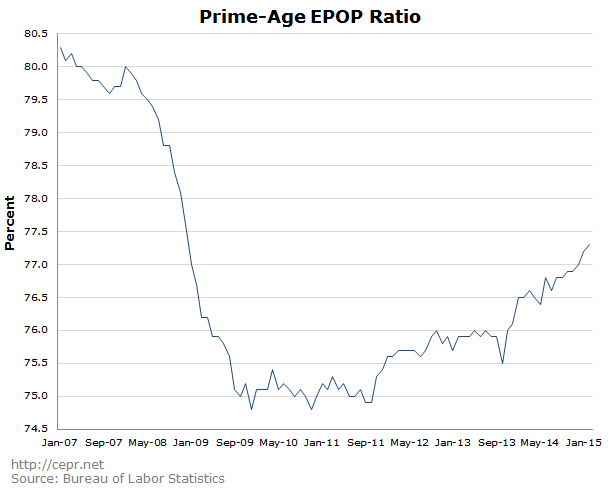March 16, 2015
Many media outlets cite the official unemployment rate—the Bureau of Labor Statistics’ U-3 unemployment rate—when reporting on the recovery in the jobs market. This rate stood at 5.0 percent in December 2007 (the first month of the recession) and rose to a high of 10.0 percent in October 2009; it has since fallen to 5.5 percent. Relative to its peak, the unemployment rate has made up 90 percent of the ground lost between December 2007 and October 2009. However, there are good reasons to think that the unemployment rate overstates the degree of recovery in the job market. We are presenting a series of five measures that provide insights on employment and unemployment that aren’t captured by the official unemployment rate. One such measure is discussed here.
Seasonally Adjusted Employment-to-Population (EPOP) Ratio, Prime-Age Population
The prime-age EPOP ratio measures the percentage of Americans aged 25 to 54 who are employed.
This measure has two strengths. First, by looking at the percentage of Americans who are employed, we are able to improve upon the standard unemployment rate, which only counts as unemployed Americans who “have actively searched for work in the prior four weeks”. Second, by restricting our analysis to prime-age Americans, we don’t have to worry about the aging of the population, which can cause the overall EPOP ratio to fall even as the economy improves. (For example, if a greater percentage of the population hits retirement age, many older Americans will make an active decision to stop working; yet this doesn’t tell us about the employment opportunities for those Americans who actually want to work. The same problem can occur if the population becomes younger and more Americans enroll in college. By looking at Americans aged 25 to 54, we avoid the problems associated with aging.)
Employment Recovery Watch
- December 2007 Prime-Age EPOP Ratio: 79.7 percent
- Trough: In both December of 2009 and November of 2010, the prime-age EPOP ratio hit lows of 74.8 percent. In both instances, the prime-age EPOP ratio recovered slightly before falling again. The last significant trough came in September and October of 2011, when the prime-age EPOP ratio fell to 74.9 percent.
- February 2015 Prime-Age EPOP Ratio: 77.3 percent
- Percent Recovered: 51 percent






